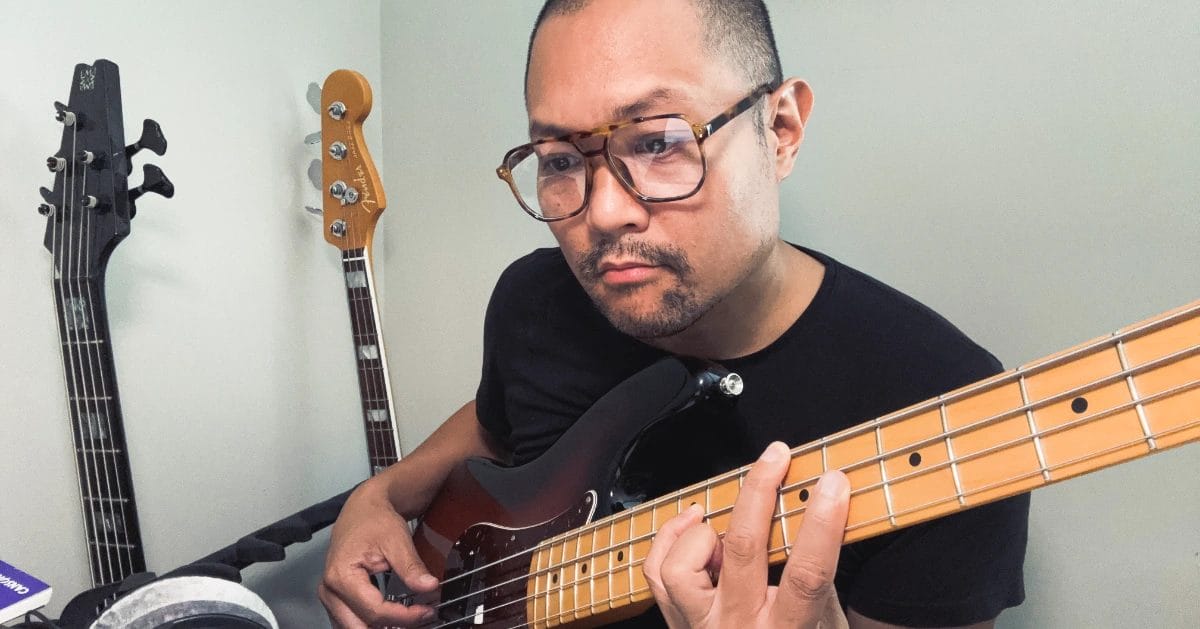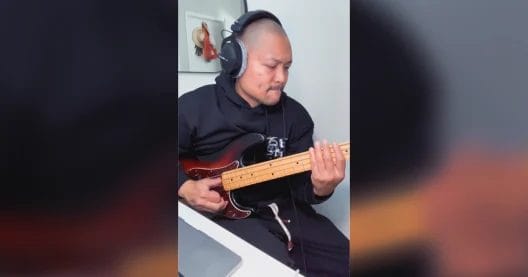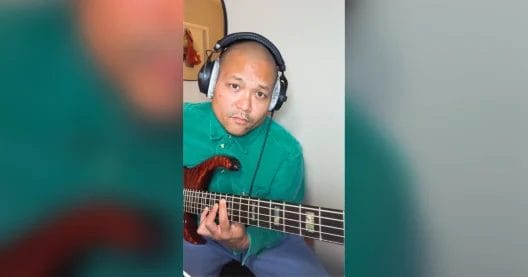When I first started out on the bass, I spent a huge amount of practice time on technique and learning my fretboard. That gave me more of an edge than I realized.
Back then, a lot of bass players were stuck in the same pentatonic shapes, running the same patterns. The more familiar I became with my fretboard, the more adventurous I felt to explore.
It’s like hiking through a dense forest: the more you know the terrain, the more likely you are to step off the beaten path. And because of that, I automatically started to sound different.
Fast forward to today—returning to my instrument after a long hiatus—my focus has shifted. My practice routine is no longer just about mechanics. My priority is my ear. The technique will come through repetition, but it’s your ear and imagination that make your bass lines connect on a deeper level.
If I could change anything about how I practiced in my early years, it would be this:
- Focus more on your ear and on music that inspires you.
- Don’t waste time grinding through lists of “must-know bass lines.”
- Pick bass lines and songs that light you up.
You will learn faster, absorb more deeply, and actually enjoy your practice.
This roadmap is here to help you balance fundamentals with freedom. You’ll see what to practice, how to structure your bass practice routine, and most importantly, how to keep your playing connected to music that excites you.
Why a Bass Practice Roadmap Matters
I can’t tell you how many times I’ve sat with my bass guitar, running an exercise, and thought: “What’s the point of this?” A perfect example was running up and down a chromatic scale. Early on, a lot of advice I got was simply, “practice your scales.” So I did. But I later realized that practicing scales just to play scales leaves you with something unmusical.

A bass practice routine needs context. Scales should connect to music: a line leading into a chord, a fragment over a chord change, or even a melodic cell you shift until it lands on a target note. That’s when practice becomes musical.
Here’s the truth: you get good at whatever you do often. If you only practice running scales up and down, you’ll get good at running scales up and down. But if you practice using those notes musically, you’ll get good at making music. If you practice developing your ear, you’ll hear and understand more ideas.
That’s why a practice roadmap matters—it helps you spend your practice time on things that translate directly into your bass lines, runs & fills, grooves, and songs you can actually play.
Let’s dive in!
Step 1: Master Your Fretboard
The first step in every bass practice routine is fretboard fluency.
- Learn every note. This makes scales, chords, and improvisation easier.
- One finger per fret and the 1-2-4 technique. Train your hand with simple dexterity exercises.
- Use a metronome. Start slow and increase bpm gradually.
- Apply notes in songs. A beginner should connect fretboard drills to real music as soon as possible.
Step 2: Build Solid Rhythm and Groove
Bass playing is about time and feel. You can know every note, but without groove your bass lines will not work.
- Clap rhythms. Before plucking the strings, clap, tap, or slap the beat.
- Practice walking bass lines. This strengthens your rhythm and chord awareness.
- Jam with backing tracks. Use drum loops or tracks to simulate playing in a band.
- Practice fluid motion. Smooth rhythm leads to smooth bass lines.
Step 3: Strengthen Technique
A good bassist needs efficient hands. Your practice sessions should include:
- Switching chords cleanly. Focus on smooth changes.
- Landing on strong tones. Practice hitting the tonic with accuracy.
- Hand health. Reset your wrist and forearm regularly.
- Warm-ups. Use short routines before every practice.
- Practice different techniques. Slap bass helps you feel the bass like a drummer.
- Challenge your mind. Exercises like my Diminished Sound Exercise work both your fingers and mind and even practicing chords.
Step 4: Add Scales, Chords, and Harmony
Understanding harmony makes you a creative bassist.
- Scales. Practice them musically, not mechanically.
- Pentatonics. Explore how minor pentatonics fit over major chords.
- Chords and arpeggios. Learn to build bass lines from chord tones.
- Guide tones. Use thirds and sevenths to create direction.
- Advanced harmony. Experiment with diminished, and modal ideas.
- Tonic gravity. Learn how to play any note and still sound good.
- Hear triads and learn how to play around with them. Triads simplify sound and require less thinking than scales and modes.
Step 5: Play Along With Music
Practicing without music can feel empty. Playing along is one of the best ways to practice bass.
- Transcribe simple lines. Even beginners can transcribe short riffs. If you want to see my transcribing process in action, go here. It’s not always pretty and good sounding.
- Play solos from other instruments. Jazz lines teach phrasing.
- Practice melody and chord melody. Bass can carry songs, not just support.
- Make bass solos melodic. Avoid sounding like scales.
- Absorb and learn from players that you admire. Attempt to play things beyond your ability.
Step 6: Create a Weekly Practice Schedule
Consistency is more important than long sessions.
- Daily practice routine: 20–30 minutes of focused practice.
- Rotate focus. Spend some days on fretboard, others on rhythm, others on concepts and improvisation.
- Track progress. Small wins add up.
- Stay motivated. Practice with patience and curiosity.
Step 7: Move From Fundamentals to Freedom
Freedom in bass playing means you can:
- Play a groove in any key.
- Solo over rhythm changes. Improvise without fear.
- Jam with others and react in real time.
- Make music, not just play exercises.
Even when you hit a rut, stay encouraged.
Frequently Asked Questions
How many hours a day should you practice bass guitar?
When I first started on bass, I was in high school and had a ton of free time. I’d practice anywhere from 5–8 hours a day. I’d play in the morning before school, then again after school, then again late at night until I literally fell asleep with my bass in hand. The funny thing is, it never felt like a chore. I wasn’t “logging hours.” I was just fascinated with the instrument and loved jamming with other musicians. That’s why I could sustain that kind of time—it felt like playing, not working.
These days, with a family and more on my plate, I aim for about 30 minutes a day. And here’s the point: it’s not about how many hours you practice, it’s about how consistent you are and how musical that practice time feels. If you can give your bass guitar focused attention—even just 20–30 minutes—you’ll grow steadily. If you have more time, great. But don’t let “not having hours” keep you from picking up your bass.
What is the 3 fret rule on bass guitar?
teach what I call the 1-2-4 technique, which is very similar to the 3 fret rule. For any notes below the 9th fret, this approach feels much more natural than trying to force a one-finger-per-fret stretch.
Here’s how it works: your hand spans three frets. Your index finger takes the first fret, your middle finger covers the next fret, and your pinky handles the third.
With this technique, the ring finger is used less often because it actually shares a tendon with your pinky. If you try to use both at the same time, that tendon is working overtime and it can feel awkward.
This 1-2-4 approach looks a lot like an upright bass player’s hand position. It keeps your fretting hand relaxed, reduces strain, and makes it easier to stay in position for longer practice sessions. Once you move higher on the fretboard, the one-finger-per-fret system becomes more comfortable. But below the 9th fret, the 1-2-4 technique is your best friend.
How to practice bass effectively?
Practicing your ear is a non-negotiable. Don’t just listen to funky bass lines or focus only on the bass. Listen to all styles of music and all instruments. The more you train your ear, the more your imagination grows—and those ideas will naturally seep into your bass playing.
Practicing rhythm is another non-negotiable. Rhythm doesn’t just mean playing “funky.” It means developing a solid quarter note. You can add as much syncopation as you want, but if your quarter note isn’t felt, it won’t groove.
Finally, make time to simply explore your instrument. A lot of bass players stay stuck because they fear the unknown. They stick with the same shapes, the same licks, the same songs, the same musicians—and years later, they still sound the same. Effective practice is about curiosity. Push into new sounds, try new approaches, and let your ear guide you. That’s how practice time turns into growth.
Is bass harder than guitar?
In many ways, bass can be harder than guitar. It’s a physically demanding instrument. When you first start, you’ll get blisters—and they hurt. Everyone also expects you to hold down the fort. You’re the foundation that lets everyone else go wild and sound good. That pressure is real, and sometimes it’s tough when you want to shine but don’t always get that spotlight.
There’s also a lot expected of modern bassists. Today’s players are laying down solid grooves, but they’re also expected to solo, improvise, and stretch out musically. So yes—you’ve got your plate full.
But here’s the thing: nothing feels like bass. When you hit that low note and it sustains, it vibrates through your body in a way no other instrument does. That’s the payoff. The bass might challenge you more, but it also connects you to music on a deeper, physical level.
Final Thoughts
A clear practice roadmap takes the stress out of learning bass and keeps you focused on what will get you sounding musical and play with freedom and fluency.
Start with fretboard basics, add rhythm, build technique, and play real music. Use resources like my Tips To Improve Your Bass Practice Routine and connect each session back to songs.
With daily practice habits, you will move from beginner fundamentals to true musical freedom. Pick up your bass guitar every day, set clear goals, and enjoy the process.
Progress is less about speed and more about sequence. Continue building your foundation inside Music & Bass →









